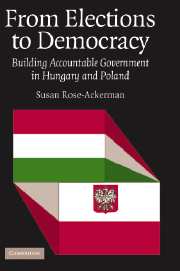Book contents
- Frontmatter
- Contents
- List of Tables
- Preface
- 1 Policy-Making Accountability and Democratic Consolidation
- 2 Alternative Routes to Policy-Making Accountability
- 3 Legacy of the Past
- 4 External Accountability and the European Union
- 5 Oversight
- 6 Decentralized Political Accountability
- 7 Public Participation in Policy Making: Government Procedures
- 8 Civil Society Groups: Overview
- 9 Environmental Advocacy Organizations in Hungary
- 10 Student and Youth Organizations in Poland
- 11 Democratic Consolidation and Policy-Making Accountability
- Appendix 1
- Appendix 2
- References
- Index
9 - Environmental Advocacy Organizations in Hungary
Published online by Cambridge University Press: 23 July 2009
- Frontmatter
- Contents
- List of Tables
- Preface
- 1 Policy-Making Accountability and Democratic Consolidation
- 2 Alternative Routes to Policy-Making Accountability
- 3 Legacy of the Past
- 4 External Accountability and the European Union
- 5 Oversight
- 6 Decentralized Political Accountability
- 7 Public Participation in Policy Making: Government Procedures
- 8 Civil Society Groups: Overview
- 9 Environmental Advocacy Organizations in Hungary
- 10 Student and Youth Organizations in Poland
- 11 Democratic Consolidation and Policy-Making Accountability
- Appendix 1
- Appendix 2
- References
- Index
Summary
Activists began to establish environmental groups in Hungary in the late 1980s when they were given space to operate by the rather progressive communist leadership that took power in 1987. The growth in these groups occurred partly in response to a law legalizing free associations passed in 1989 (Harper 1999: 58–93; Pickvance 1998: 75–76 Pickvance and Gábor 2001: 105). During that period a core group of activists mobilized large numbers of people to protest particular issues. These mobilizations continued into the democratic transition (Pickvance and Gábor 2001). According to Pickvance and Gábor (2001: 105), the emergence of environmental groups in the mid-1980s was tolerated when other types were not:
because they were not viewed as a potential threat to the regime. … This led to a situation in which before the regime change environmental issues attracted politically minded people who either blamed the regime for the lack of responsible policies or joined green movements to express their discontent without running the risk of a direct confrontation with the regime.
During the 1990s, citizens founded large numbers of new groups, but most were small, volunteer organizations with few funds (Kuti et al. 2000: 15–16). Nevertheless, several more professional organizations currently play a key role in government policy-making processes. Some of these date from the socialist period; others are more recent creations. The most active are several specialized umbrella organizations dealing with issues such as air pollution, waste management, energy, and nature protection.
- Type
- Chapter
- Information
- From Elections to DemocracyBuilding Accountable Government in Hungary and Poland, pp. 175 - 191Publisher: Cambridge University PressPrint publication year: 2005



